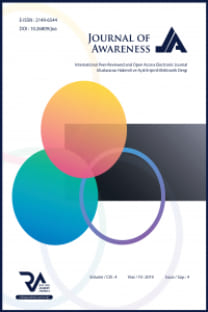ENTREPRENEURIAL ATTITUDE, ENTREPRENEURIAL SOCIAL ENVIRONMENT AND THE ENTREPRENEURIAL ABILITY TO ENTREPRENEURIAL INTENSITY TO BE YOUNG ENTREPRENEUR ON KABUPATEN MINAHASA INDUK
Entrepreneurial Attitude, Entrepreneurial Social Environment Entrepreneurial Ability, Entrepreneurial İntensity,
___
- Ajzen, I. 2001. Nature and Operation of Attitudes. Annual Review of Psychology. 52: 27-58.
- Astamoen, M. P. 2005. Entrepreneurship in Indonesian condition perspective. Bandung: Alfabeta.
- Choo, S. dan Wong, M. 2006. Entrepreneurial Intention: Triggers and Barriers to New Venture Creations in Singapore. Singapore Management Review. 28(2): 47-64. Indarti, N. 2008. Factors Affecting Entrepreneurial Intention Among Indonesian Students. Economic and business journal. 19(1): 57-70.
- Jogiyanto. 2007. Behaviour Information System. Yogyakarta: Andi Published.
- Katz, J. A. dan Gartner, W. B. 1988. Properties of Emerging Organization. Acad. Management Review. 13: 429–441.
- Kojo, Ch., Mintardjo, Ch. M. O.M., and Pangemanan, S. S. 2012. Entrepreneurial Intention in a business based science and technology and environmentally friendly in university students home affairs in north sulawesi. Research of Lemlit Unsrat
- Kompas, 2016. Kompas newspaper, Unemployment rate in Indonesia, Jakarta
- Krueger, N. and Carsrud, A. 1993. Entrepreneurial Intentions: Applying the Theory of Planned Behavior. Entrepreneurship and Regional Development. 5(1), 3 15-330.
- Liñán, F. and Chen, Y. 2007. Testing the Entrepreneurial Intention Model on a Two Country Sample. Document de Treball num. 06/7. Departement d’Economia de l’Empresa. Universitat Autonoma de Barcelona.
- . and Chen, Y. 2009. Development and Cross-Cultural Application of A Specific Instrument to Measure Entrepreneurial Intentions. Entrepreneurship Theory and Practice. May 2009: 593-6 17.
- Lupiyoadi, R. 2007. Entrepreneurship: From Mindset to Strategy. Jakarta. BPFE UI.
- Mintardjo, Ch. M. O. M. 2010. Factors that affects Entrepreneurial intensity students in the eastern part of indonesia. Proceeding National Entreprenuer Seminar November, 78-92.
- . 2011. Intensity entrepreneurship students as factors that commenced the process of entrepreneurship students, Megadigma Journal. 4(3): 391-404.
- Nugroho, R. 2013. Understand the background of Entrpeneurship Ciputra. Jakarta. Elex Komputindo Media.
- Rostiani, R. 2008. The intensity of entrepreneurship students: Comparation Study between Studi Indonesia, Japan and Norwegia. Ekonomika and Indonesian business journal. 23(4), Oktober 2008.
- Sugiyono. 2010. Research methodology business. Bandung: Alfabeta.
- Tjahjono, H. K., & Ardi, H. 2008. The intention of Muhammadiyah University student management yogyakarta to be entrepreneurs. Utility Management and Business Journal. 16(1) : 46-53.
- Trang, 2016. Competitive strength and its impact toward achieving company’s performance based on balanced scorecard aproach in the furniture industry in central minahasa regency , Journal of Life Economics, Turkey. 3 (2) : 87-100
- Wu, S., dan Wu, L. 2009. The Impact of Higher Education on Entrepreneurial Intention of University Students in China. Journal of Small Business and Enterprise Development. 15(4) :752-774.
- Yamin, S., dan Kurniawan, H. 2009. SPSS Complete: The Engineering statistical analysis comprehensive SPSS series 1. Jakarta: Salemba Empat.
- ISSN: 2149-6544
- Başlangıç: 2016
- Yayıncı: Rating Academy
TÜRKİYE'DE BİLGİ EDİNME HAKKI: BÜYÜKŞEHİR BELEDİYE WEB SAYFALARI ÜZERİNDEN BİR DEĞERLENDİRME
Filiz TUFAN EMİNİ, Çağlar Eren AYAZ
Halide OKUMUS, Ateş ARCASOY, Arzu MİRİCİ
İrvan TRANG, Christoffel Mardy O. MINTARDJO
21. YÜZYILIN İDEOLOJİK GÜÇ MÜCADELESİ: ULUSLARARASI SİSTEMİN DEĞİŞEN DOĞASINI ANLAMAK
İSPANYA’NIN ALTIN ÇAĞINDA SEVİLYA KENTİNİN İSPANYOL SANATINDAKİ YERİ
